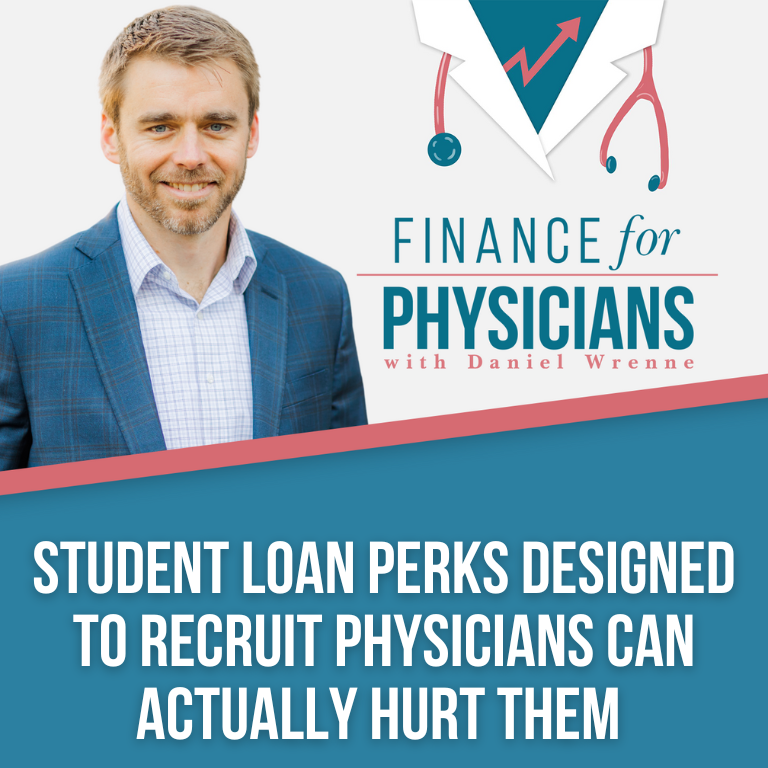Many physicians entering practice today owe more than $200,000 on their federal student loans. It’s become a major priority to address these massive loans as they enter into practice.
As a result, hospitals are introducing physician loan repayment perks for new hires to drive recruitment. However, confusing intricacies with the new Public Service Loan Forgiveness program “PSLF” are causing major unintended consequences.
Here’s how the typical physician loan repayment perk goes:
Dr. Smith is finishing training and owes $400,000 on his student loans. He signs on with a hospital for three years of employment and, in exchange, the hospital will pay $75,000 toward his student loan balance. The hospital pays the $75,000 directly to the loan servicer in one, lump-sum payment (or sometimes spread out over three annual payments). If Dr. Smith breaks his contract early, he must repay some or all of the stipend.
At first glance, it’s a win win. The hospital wins by getting Dr. Smith to sign on. Dr. Smith wins by receiving help with his massive student loans.
PSLF Game-Changer
Public Service Loan Forgiveness “PSLF” totally changes the game. Physicians who have qualified loans and are employed (full-time) by a qualified employer and make 120 qualified payments can receive tax-free forgiveness of any remaining balance (after they successfully prove everything was “qualified”).
Qualified loans are federal direct student loans – these are by far the most common type of student loans young physicians take out for medical school. If they happen to be federal non-direct, there are methods to change them into direct to make them “qualified”.
Government, 501(c)3, AmeriCorps, Peace Corps and other qualifying public service employers are considered qualified employers. The majority of hospitals (and residency programs) in the US fall into this category.
A qualified payment is a successful payment made to any qualified loan under any of the income-driven repayment plans or the 10 year standard repayment plan while employed by a qualified employer. These income-driven payments are exactly what they sound like – payments set based on income. Lower income equals lower payments and under most plans, there is a payment cap.
Maneuvering PSLF
Any medical resident with any wherewithal will rack up low PSLF qualifying payments and set themselves up to receive massive PSLF benefits if they end up with a qualified employer. The value builds during residency and remains even if the new physician scores an extremely high-paying job. It’s not uncommon for us to see physicians making mid six-figure salaries on track to receive tax-free six-figure PSLF forgiveness.
PSLF makes student loans unlike any normal debt. With normal debts, the more you pay, the less you end up paying back. Extra payments to principal are great because you save interest. With PSLF, the less you pay, the less you end up paying back. All payments are equal for PSLF therefore, lower payments are always better for the borrower. The $0/mo qualifying payment has the same PSLF value as a $3,000/mo qualifying payment. Once you rack up 120 qualified payments, all remaining qualifying debt vanishes tax-free. The physician that ends up paying the lowest possible total 120 qualifying payments will maximize PSLF value. In most cases, additional payments to principal are worthless. Seems odd right? If you don’t believe me, check out the rules.
Student Loan Perks for New Doctors
As 501(c)3 hospitals implement student loan repayment perks, they fail to consider the PSLF benefit. In the earlier example, Dr. Smith also happens to be on track for PSLF. In fact, he signed on with this hospital partly because they were a 501c3 so that he could continue qualifying for the program. He’s already satisfied 60 PSLF qualifying payments during residency and fellowship. Therefore, all he needs is 60 more payments to receive full forgiveness. Dr. Smith isn’t sure how the $75,000 will affect PSLF however he assumes it can’t hurt. As strange as it might seem, the $75,000 paid toward his student loans has no affect on PSLF except that it’s taxable income and therefore increases his total remaining payments by $7,500. It turns out he would have been better off receiving nothing. On top of this, Dr. Smith has to pay tax on the $75,000. IF we assume the tax is 40%, that’s $30,000.
In this case, Dr. Smith would have benefited $37,500 by declining the student loan perk. The hospital would have also saved $75,000. That’s $112,500 of missed opportunity.
PSLF Friendly Student Loan Perks
One solution would be for 501c3 hospitals to stop paying student loan stipends directly to servicers. Instead they could pay the borrower directly. However this would not incentivize physicians to maximize PSLF and it wouldn’t save the hospital any money.
To accomplish the desired outcome, 501(c)3 and government hospitals must restructure their student loan recruitment perks to consider PSLF. Because of it’s surprising complexity, it’s rare to see physicians maximizing the program.
A better solution would be for hospitals to use a small portion of their “student loan perk” funds to hire student loan consultants for their new physicians to help them navigate and maximize PSLF. Hospitals could then reimburse the physician for successful PSLF payments made. This would incentivize physicians to manage PSLF effectively and lower the hospital’s loan reimbursement payments. This would save the hospital money and help physicians eliminate their student loan burden faster.
PSLF has changed the game and hospitals must adapt if they want to attract and retain top physician talent. It’s only a matter of time before hospitals figure this stuff out and start offering new and improved recruitment incentives that help address the student loan problem. In the mean time, if you have a similar offer, it’s worth having a conversation with your employer about an alternative set-up that could ultimately save you thousands.
